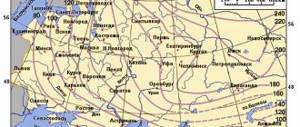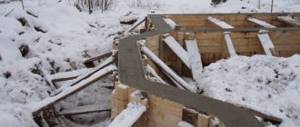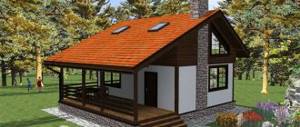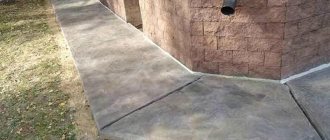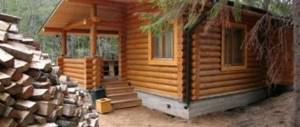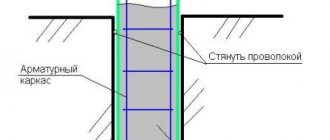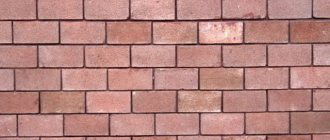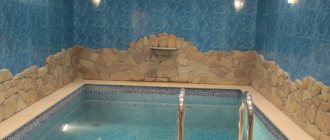Quality and composition of concrete
The grade of concrete is a determining indicator of its qualities. The usual marking for the construction market is the letter “M” and numbers that indicate the tensile strength of the material in kg/cm2.
In residential construction, concrete grades from M150 to M350 are used for pouring foundations. For their production, cement M400 and M500 is used in various proportions with solid fillers and water. The brand and strength of the final product depends on the quantity and quality of cement.
The content of impurities in cement should not exceed 20%. The special marking of cement, designated by the letter “D,” indicates the percentage of impurities in it.
The following solid fillers are used: sand, crushed stone, gravel or an enriched sand-gravel mixture. The finished solution should contain gravel grains of various sizes. Fine gravel fills the voids between large fractions and provides the design strength of the material.
How to improve the characteristics of concrete?
The quality of the prepared solution and future construction can be improved by adding mountain gravel, which fills the voids between the fractions. Sometimes plasticizers are added, which increase the quality of the solution by 25%. However, builders prefer to enhance concrete characteristics by increasing moisture resistance. This is achieved with a waterproofing layer, namely a hydrophobic layer, which is laid at the bottom of the trench before pouring the solution.
Choosing the optimal brand of concrete for the foundation of a bathhouse
The weight of the building materials from which the construction of load-bearing walls is planned depends on what kind of concrete is needed for the foundation of the bathhouse. The design and lower elevation of the foundation are determined by the composition, depth of soil freezing and groundwater level.
Columnar supports are usually installed under light wooden or frame buildings. The brick walls of the bathhouse are erected on a strip foundation. In special cases, a monolithic slab under the entire area of the bathhouse is used as a foundation. All of the listed types of foundations are made of concrete mixture and metal reinforcement elements.
The grade of concrete for the foundation is determined based on the characteristics of the soil at the building site:
- M150 is used for pouring shallow foundations on dense, homogeneous soil or rocks;
- M200 - for a strip base on sand with an aquifer below the soil freezing mark;
- M250 and M300 – on moving soils with a high level of water rise;
- M350 - on heaving foundations, prone to expansion during soil freezing and uneven subsidence during a thaw;
- M400 - used extremely rarely, for particularly strong foundations in wetlands.
If the geology of the site is complex, you should not skimp on quality and use a lower grade, guided only by the weight and overall dimensions of the bathhouse. On a construction site with moving soil, the M350 grade should be used to fill the foundation for a bathhouse in order to provide a margin of safety and increase the service life of the building.
In order not to increase the grade of concrete, when laying a deep foundation, good waterproofing of its underground part is used. You can strengthen the base structure by increasing the number and diameter of the reinforcement.
Laying stages
Territory marking
Determining the boundaries of the future foundation is carried out in stages:
- They draw a line and fence it with rods, attaching a thread between them.
- The transverse sides are laid at an angle of 90 degrees from the edges of the laid segment.
- After the formation of the external boundaries, it is necessary to determine the internal ones. The thickness of the future foundation, depending on the building materials, is 40-50 cm.
- At the sites of future partitions, markings of the foundation are also made.
Laying a trench
After marking the territory, you need to remove the excess earth for the future foundation of the bathhouse. Before starting work, the lower level is determined using a water level. After this, they begin to dig trenches, reaching 40 cm on non-heaving soil, and heaving soil will require calculation of the freezing level, to which another 20 cm is added. This is a recess recommended for laying the foundation of the planned building.
Preparation of formwork
Creating a simple foundation will require the construction of formwork, for which you can use boards or thick plywood. Manufacturing takes place directly at the construction site. Separate parts are prepared, placed in trenches and connected to each other. The inner side is equipped with spacers, and the outer side with supports. This will help the structure maintain its shape during the process of pouring the solution.
Before forming the base of the building, the formwork is assembled.
Reinforcement
Iron rods, which are placed in the formwork before laying the concrete, will help strengthen the foundation of the future bathhouse. Cells measuring 30-35 cm should be formed; for this, part of the reinforcement is driven in at an angle of 900 to the ground. At the bottom and top of the trench there is a part of the rods that are tied to the posts. The process is completed by installing transverse jumpers, after which the frame is ready.
Waterproofing
There are several ways to improve the moisture resistance of the foundation:
Preparing concrete for the bathhouse foundation
To prepare the solution, use Portland cement (M400 or M500) with a silicate content of up to 80%. This allows kneading to be done at lower temperatures.
Depending on the moisture content of the source material, the amount of water per fraction of the dry mass of the solution may vary, so water is added in parts. At the beginning of the kneading, take 2/3 of the water, gradually adding water during the cooking process until a homogeneous plastic mass is obtained.
Experienced builders advise preparing a solution for the foundation of a bathhouse from an enriched sand-gravel mixture (OPGS) in a volume ratio of 1/8 or 1/6 in order to obtain grades of concrete, respectively: M150 and M200 from M400 and M500 cement; M200 and M300 from cement M400 and M500.
Instructions for mixing M300 concrete from OPGS in a 125 l mixer:
- Turn on the unit without filling it with ingredients;
- Tilt the mixer to the first position and pour in 5 liters of water;
- Fill 6 buckets of OPGS of the 4th group with a grain size of 5–20 mm;
- Tilt the mixer to the second position and fill in 1 bucket of M500 cement;
- Add 3 liters of water, depending on the humidity of the OPGS;
- The readiness of the solution is determined by color and consistency.
Attention to components
Cement
There are several varieties on the market. With and without various additives. For example: normalized / with low water absorption / fast-hardening / protected from aggressive environments / frost-resistant, etc. Always proceed from your construction conditions.
Armature
There are two types of it: iron and polymer*. Particular attention to the correct arrangement of the frame. Type of reinforcement, brand, cross-section, condition (so that there is no rust), knitting material (which is also iron and polymer) and so on.
*a review article was recently published covering the “reinforcement topic”, specifically for strip foundations.
The reinforcement cage must be included in the thickness of the strip concrete, however, it should not come into contact with the walls, bottom or extend beyond the belt.
Other components of the solution
They are selected based on construction conditions (load, soil type, etc.). Depending on the need, sand, clay, lime, gravel, crushed stone, special additives, etc. are mixed in different proportions. The moister the soil, the greater the “proportion” of cement in concrete.
The proportions of ingredients are given in reference books and recommendations of concrete manufacturers. However, its composition depends on the fraction of gravel, crushed stone and even sand. In addition, the indicator of “freshness” of cement is important. After the shelf life expires, it begins to “lose” its brand. It was 500, became 400, was still in storage, became 300, etc.
Never use cement that is past its expiration date. A lot depends on the quality of cement, and first of all, the durability of your structure...
One more thing. Many suppliers declare the price for 1 ton, but we are “tied” to 1 m³. What you need to understand. For example, the specific gravity of sand depends on its origin. River sand, heavier than quarry sand, etc. The situation is similar with crushed stone and gravel. The smaller the fraction, the greater its mass in one cubic meter.
Practical recommendations
You can determine what brand of concrete is needed for the foundation of a bathhouse without weighing and complex calculations. The method is based on meeting the conditions under which the most durable material is obtained. The cementitious emulsion should fill all the free space between the solid fractions of the mixture.
To do this, take a measuring container and a 10 liter bucket. The sand and gravel mixture is poured into a bucket and filled with water, measuring the volume using a measuring cup. When the water rises to the surface of the mixture, record the measured volume of water. This will be the volume of cement that needs to be added to the solution.
If you managed to pour 2 liters of water into the bucket with the filler, then to obtain concrete, mix a bucket of sand-gravel mixture and 2-liter measures of cement. The cement-mixture proportion will be 1/5. Water is added to the dry mixture in portions until a plastic mass is formed.
The proportions for creating popular brands of cement can be as follows:
- M 100. Composition: cement - 220 kg / crushed stone - 0.8 m³ / sand - 0.6 m³ / water - 180 l;
- M 200. Composition: cement - 280 kg / crushed stone - 0.8 m³ / sand - 0.5 m³ / water - 180 l;
- M 250. Composition: cement - 330 kg / crushed stone - 0.5 m³ / sand - 0.6 m³ / water - 180 l;
- M 300. Composition: cement - 380 kg / crushed stone - 0.8 m³ / sand - 0.45 m³ / water - 180 l.
General requirement. To produce high-quality concrete mortar, the grade of Portland cement used must be twice (!) the grade of ready-made concrete. That is, to obtain high-quality concrete M200, the best grade of cement is 400.
However, a small caveat: for more durable grades of concrete M300 - M500 and higher, the ratio of cement to the final product can be reduced to 1.5.
As mentioned, the grade of concrete depends on the load that the foundation must compensate. Moreover, the strip foundation can be monolithic or composite. Monolithic, poured completely and made in the form of a single indivisible structure. Composite, assembled from concrete blocks installed tightly together.
Monolithic means poured quickly. If the concrete for a strip foundation sets before the formwork is completely poured, “cold” seams will appear in its structure. Which are just as harmful as cracks.
